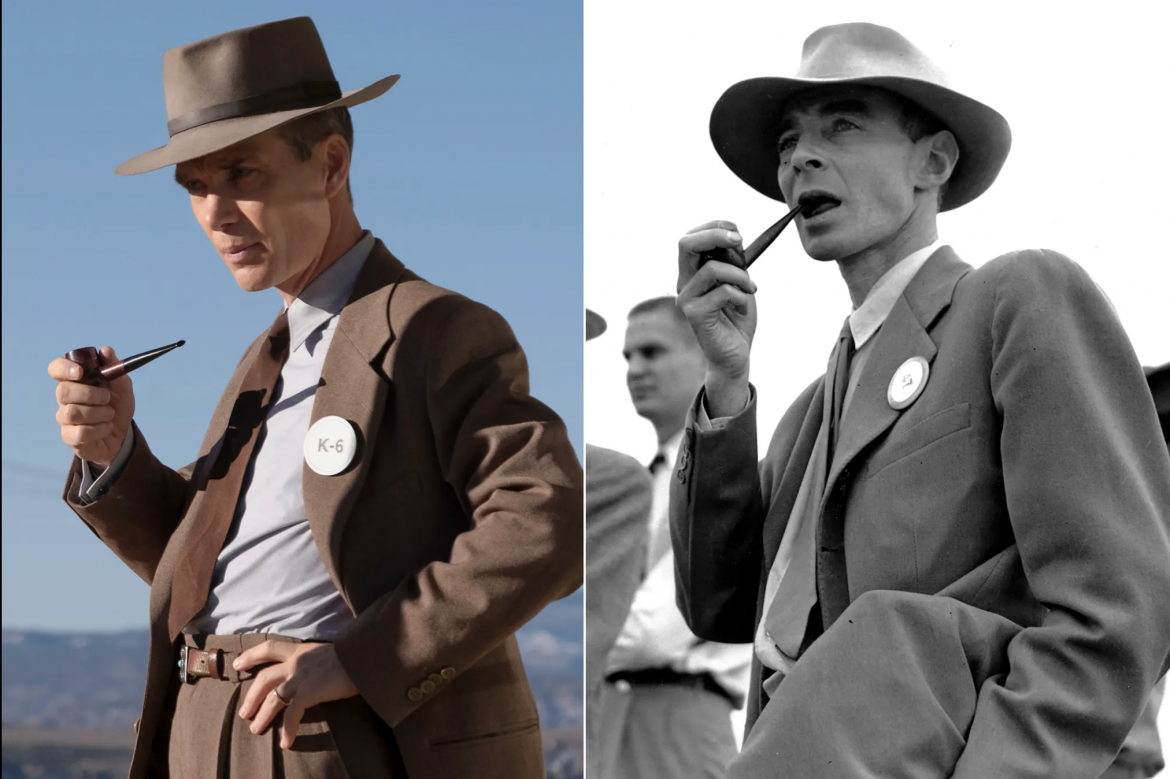
Movies and Realities: Oppenheimer vs. Oppenheimer
Released this summer and making its mark in the world of cinema, renowned American director Christopher Nolan’s film focuses on the life of the famous physicist J. Robert Oppenheimer, especially his story revolving around the Manhattan Project, which involved producing the atomic bomb in the US, has aroused a lot of interest both among viewers and in the world of science. In the movie, we also see characters that many of us know, such as Albert Einstein and Niels Bohr, who played important roles in Oppenheimer’s life.
Based on the Oppenheimer biography “American Prometheus” by Martin J. Sherwood and Kai Bird, the film is considered to be Nolan’s best. However, scientists who know Oppenheimer well believe that the facts are distorted or underrepresented for the sake of creating a visual feast – as Hollywood often does. In the end, movies made about the atomic bomb shortly after the Second World War had a tint of propaganda to justify this critical move that changed world history and was responsible for the deaths of more than a hundred thousand people, or merely to salve the conscience of the United States. In 2023, these concerns may be behind us, as we see Nolan focusing on Oppenheimer’s conscientious burden as the “father of the atomic bomb”. However, he also goes into some of the details of the Manhattan Project, which was carried out in great secrecy and with a huge budget to produce an atomic bomb before the Germans did.
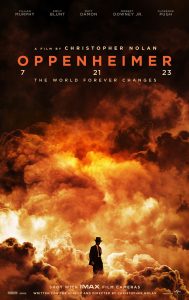
Taking advantage of the opportunity created by the huge interest in the movie, we wanted to take a look at J. Robert Oppenheimer and the Manhattan Project, and the views on how the movie reflects facts, blending things a little with atomic energy physics.
What is the Manhattan Project?
The Manhattan Project, which the United States carried out with an enormous budget with the ambition of becoming the first nuclear-powered country, and thus a global player in the world, is thought to be based on a very simple fear: The possibility that Nazi Germany might produce an atomic bomb before anyone else. It is arguably due to the same reason why Oppenheimer led the project with such passion. Nazi Germany under Hitler’s rule spread so much terror around the World that it had to be stopped at all costs.
It all started in 1939. The announcement by German scientists Otto Hahn and Fritz Strassmann that they had discovered nuclear fission triggered the concerns of scientists Leo Szilard, Edward Teller, and Eugene Wigner, all three of Hungarian descent. The trio, along with Albert Einstein, first approached the Queen of Belgium and then US President Roosevelt, explaining the extent of the danger. (The Queen of Belgium was important because the uranium mined in Congo, which was then under Belgian rule, should not have been sold to the Germans.) Roosevelt, of course, took the matter seriously, and the committee he set up to investigate the possibility of producing a nuclear weapon began laying the foundations for the project in 1941.
The project started in facilities established at three main locations: uranium bought from Congo was being enriched in Oak Ridge, Tennessee; uranium was then converted into plutonium in reactors in Hanford, Washington; and atomic bomb designs and relevant experiments were carried out in the laboratories run by Oppenheimer in Los Alamos, New Mexico. In addition to these three locations, dozens of smaller facilities established to support the project were run in strict secrecy. According to World War II historian Alexandra Levy, the majority of more than 600,000 workers, technicians, engineers, and scientists working on the project did not know what they were working on. If the project was carried out today, this level of secrecy would probably not be possible because of the prevalence and extent of communication technologies. It is also worth noting that the entire project cost around US$37 billion in today’s dollars.
Although Oppenheimer was directly responsible for some of the scientific discoveries that made the Manhattan Project possible, it can be said that his most important characteristic that enabled the successful completion of the project was his managerial approach that brought together a large number of scientists, engineers, and technicians to collaborate to overcome technical obstacles.
Oppie, as he was known, never recovered from the remorse of the atomic bombs “tested” in Japan after the project ended. Nazi Germany had already ceased to be a serious nuclear threat by 1945. “But he knew that nuclear weapons were going to be built anyway, and he felt that he had a duty to do this horrible thing,” says science historian Alex Wellerstein.
Who is Oppenheimer?
The reputed theoretical physicist Julius Robert Oppenheimer was born in 1904. After studying chemistry at Harvard University (USA), he went to the University of Cambridge (England), where he left after two years, to go to the University of Göttingen (Germany). There, he earned his Ph.D. degree in theoretical physics when he was only 23. In the same year, he was called by both Harvard and Caltech (California Institute of Technology). He finished his fellowship with a split program between the two and carried on to work in two more universities in Europe. In the meantime, he wrote dozens of papers.
He eventually returned to the United States and became a physics professor University of California in 1936. His contributions to science include research in quantum mechanics, quantum field theory, nuclear physics, and theoretical astronomy. He was the first to predict the existence of positrons, and quantum tunneling. He also predicted the existence of black holes, neutron stars, and a limit to the mass of stars. He explored the properties of white dwarfs and the interactions of cosmic rays. In 1942, he was assigned to Los Alamos Laboratory and a year later, he was tasked with developing the first nuclear weapons as part of the Manhattan Project.

After the Manhattan Project was completed, Oppenheimer was appointed director of the Institute for Advanced Study at Princeton in 1947 and served on the Committee of General Counsel of the US Atomic Energy Commission. He lobbied for international control of nuclear power and opposed the idea of developing the hydrogen bomb.
In 1954, as a result of a security hearing, his access to the government’s atomic secrets ended –along with his academic career. The hearing was mostly based on his Communist and left-wing affiliations and the fact that he had delayed reporting an incident where he was approached for indirectly sharing technical nuclear secrets with the Soviet Union (by Haakon Chevalier). His opposition to the development of the H-bomb was also put forth in the hearing.
After this incident, Oppenheimer still carried on working in physics, gave public lectures, and wrote public papers. He established the World Academy of Art and Science in 1960 with Albert Einstein, Bertrand Russell, and Joseph Rotblat. He was given the Enrico Fermi Award in 1963. However, he died from throat cancer four years later, in 1967. He was married to Katherine “Kitty” Oppenheimer, for 27 years, with whom he had two children.
In 2022, the revocation of Oppenheimer’s security clearance was vacated by the US Government.
The Movie and The Reality
Adapted from the biography American Prometheus, the movie uses almost every anecdote and dialog in the book. Although it is regarded as one of the most faithful biographies in this respect, some changes can be made in such productions to keep the audience’s interest alive and improve the cinematic narrative. Let’s examine some of the most important differences between the movie and the reality.
Did Oppenheimer try to poison Blackett?
However exaggerated and unrealistic this anecdote sounds, it is mostly true. Although Oppenheimer is known to have injected some substances into Patrick Blackett’s apple out of jealousy and self-perceived inadequacy, it is not clear which chemicals he used. This incident almost got Oppenheimer fired from Cambridge, but the scientist’s family prevented it. Also, Niels Bohr had no role in the incident, even though he was included in the movie to show his admiration for the famous physicist.
Did he consult Einstein?
Edward Teller, who later invented the hydrogen bomb himself, did indeed express concern that a nuclear weapon could ignite the Earth’s atmosphere. However, it was not Albert Einstein that Oppenheimer went to consult on this matter. According to the book, Oppenheimer had asked Carl T. Compton to review the calculations.
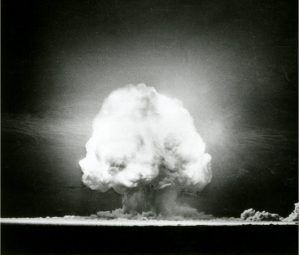
Effects of the Trinity test
After the bomb went off, there was indeed silence for a while. “Finally, after about a minute and a half, there’s suddenly a tremendous noise –BANG, and then a rumble, like thunder,” Richard Feynman later recounted.
However, the movie does not tell about the test’s effect beyond the scientists and military personnel who watched the test from various distances. In reality, the brightness of the flame, the sound of the explosion, and the concussion of the blast wave were noticed throughout the entire region. Windows shattered in nearby cities and the residents of Amarillo, Texas, were able to see the bright flash from some 450 kilometres away.
The government, on the other hand, published a fake story that an arsenal had exploded but no one was injured.
Kyoto’s elimination
The selection of targets for the atomic bomb was a complex process involving many people, including Oppenheimer and the Secretary of War, Henry Stimson.
In the movie, Stimson says that they should not bomb Kyoto because of its cultural significance and because he and his wife went there after they were married, but there is no information regarding whether he went there for his honeymoon.
Long-term effects
Although Oppenheimer is portrayed in the film as the only one with concerns and questions about the long-term effects of nuclear weapons in meetings with Groves and Stimson, many like-minded people were said to have taken the matter quite seriously at the highest levels of government. Stimson, who conveyed these concerns to President Harry Truman, is said to have also shared these thoughts.
Areas outside Los Alamos
The film focuses closely on Los Alamos, New Mexico, which was Oppenheimer’s place of residence at the time and thus the place where much of the Manhattan Project’s work was done. However, General Leslie Groves had approved two other locations for use in the Manhattan Project: Oak Ridge, Tennessee, and Hanford, Washington. Oak Ridge had a uranium enrichment plant, and in its heyday the site housed more than 12,000 workers. Hanford was where plutonium was produced. Los Alamos was largely used exclusively for designing and developing the atomic bomb.
How Does an Atomic Bomb Work?
All matter is made up of atoms. Each atom has a nucleus consisting of positively charged protons and neutral neutrons. Each element has a unique number of protons, but the number of neutrons in the nucleus can vary. Variations with the same number of protons but different numbers of neutrons are known as isotopes. Some isotopes are unstable, which makes them radioactive.
Uranium-235 (235U) is a valuable isotope for the defense and energy sectors as a primary fuel for a nuclear weapon or a nuclear power plant.
The destructive power of nuclear weapons comes from two processes: nuclear fission, in which an atomic nucleus is split into two smaller parts by a neutron”, and nuclear fusion, which involves the fusing of two smaller atoms together to form a larger one”.
In nuclear fission, which is used in the weapons developed by the Manhattan Project, neutrons collide with the nucleus of an unstable isotope, uranium-235 or plutonium-239, forcing the nucleus to break apart and release enormous amounts of energy.
When a free neutron hits the nucleus of a fissile atom such as 235U, the uranium nucleus splits into two smaller nuclei, called fission fragments, and more neutrons (on average just under 2.5 per fission for 235U).
When the first atom splits and releases neutrons, it is necessary to ensure that these neutrons hit another atom in a chain reaction. The problem is that you cannot control where the neutrons go, you can only force the odds in your favour.
Atomic weapons contain very large quantities of fissile material to ensure that the chain reaction takes place. The reason for this is to ensure that the released neutrons, on average, will be able to hit another nucleus. Having enough material to ensure this is called having a critical mass.
A fission chain reaction in a supercritical mass of fuel can be self-sustaining because it produces enough extra neutrons to compensate for the neutron loss escaping the supercritical structure. Most of these have the speed, or the kinetic energy, to cause new fissions in neighbouring uranium nuclei.
Little Boy
Of the first two types of bombs developed at Los Alamos, Little Boy, the one dropped on Hiroshima, was a so-called gun-type design.
The design has two separate masses of uranium-235 at either end. Each of these masses is too small to make a nuclear explosion on its own. However, the combination of both masses raises the total mass to the critical mass level. The first mass of uranium-235 is pushed towards the second mass by explosives. The critical mass is only reached when the two masses are combined.
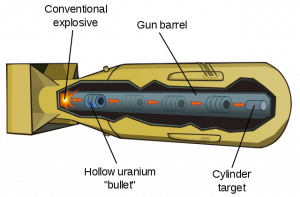
When uranium-235 is at critical mass, nuclear fission reactions begin spontaneously inside the nucleus. Uranium nuclei split, producing smaller particles and huge amounts of energy. This energy interacts with surrounding atoms, triggering more fission reactions.
The energy released as a result of nuclear fission reactions leads to a huge explosion and a devastating shock wave. Radiation is also released, causing serious damage and long-term effects on the environment.
Fat Man
The Plutonium-239-based atomic bomb dropped on Nagasaki was dubbed the “Fat Man”. The working principle of this bomb was to create a nuclear explosion by rapidly compressing the plutonium nucleus. At the centre of the Fat Man design is a sphere of plutonium-239 nuclei. A complex device compresses this sphere with explosives around it.

A series of conventional explosives placed outside the central mass are detonated simultaneously. These explosives exert intense pressure on the plutonium core, generating very high pressures and temperatures that appear in waves. This shock wave pushes the nucleus closer to its critical mass, the mass limit necessary for a nuclear explosion to occur.
Historical Effects
The atomic bombs developed had a profound impact on world history and led to a series of important consequences.
The End of World War II
When the atomic bombs were dropped on Japan, the cities of Hiroshima and Nagasaki were devastated. These attacks contributed significantly to Japan’s surrender. The use of atomic bombs is thought to have hastened the end of the war, saving millions of lives, as it was anticipated that there would have been more casualties in the event of a conventional attack and invasion.
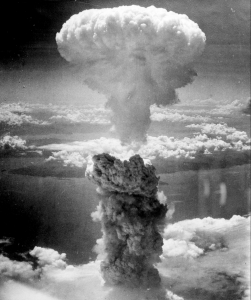
The Cold War Era and the Fear of Balance
Following World War II, a political and military rivalry began between the United States and the Soviet Union. During this period, the development and proliferation of nuclear weapons posed a major threat. Throughout the Cold War period, the possibility of a nuclear conflict between the parties remained a threat to world peace. The presence of nuclear weapons created a kind of “fear of balance” between the parties during the Cold War. Considering that a nuclear war would have devastating consequences if one side prevailed over the other, the parties remained wary of each other.
Controlling the Proliferation of Nuclear Weapons
The destructive power of atomic bombs led international powers to take serious steps to control the spread of nuclear weapons. In this framework, the Nuclear Non-Proliferation Treaty (NPT) was signed in 1968. Following this, nuclear disarmament movements also began.
Space Race and Technological Development
The development of atomic bombs led to major advances in nuclear physics and technology. These advances also had an impact on the space race and other technological fields.
The development and use of atomic bombs had a lasting impact on the history of the world and led to significant changes in many areas including international relations, security strategies, arms control and international peace efforts.
REFERENCES
- 1. https://ahf.nuclearmuseum.org/ahf/history/einstein-szilard-letter-1939/
- 2. https://en.wikipedia.org/wiki/American_Prometheus
- 3. https://www.scientificamerican.com/article/what-was-the-manhattan-project/
- 4. https://www.vulture.com/2023/07/oppenheimer-historical-accuracy-what-really-happened.html
- 5. https://www.businessinsider.com/oppenheimer-fact-vs-fiction-what-the-movie-got-right-wrong-2023-7
- 6. https://www.atomicarchive.com/
- 7. https://ahf.nuclearmuseum.org/ahf/history/science-behind-atom-bomb/
